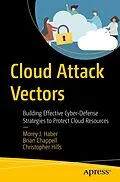Cyberattacks continue to increase in volume and sophistication, targeting everything owned, managed, and serviced from the cloud. Today, there is widespread consensus-it is not a matter of if, but rather when an organization will be breached. Threat actors typically target the path of least resistance. With the accelerating adoption of cloud technologies and remote work, the path of least resistance is shifting in substantive ways. In recent years, attackers have realigned their efforts, focusing on remaining undetected, monetization after exploitation, and publicly shaming organizations after a breach.
New, innovative, and useful products continue to emerge and offer some cloud protection, but they also have distinct limitations. No single, standalone solution or strategy can effectively protect against all cloud attack vectors or identify all malicious activity. The simple fact is that the cloud is based on a company's assets being offered as services. As a result, the best security any organization can achieve is to establish controls and procedures in conjunction with services that are licensed in the cloud.
Cloud Attack Vectors details the risks associated with cloud deployments, the techniques threat actors leverage, the empirically-tested defensive measures organizations should adopt, and shows how to improve detection of malicious activity.
What You'll Learn
- Know the key definitions pertaining to cloud technologies, threats, and cybersecurity solutions
- Understand how entitlements, permissions, rights, identities, accounts, credentials, and exploits can be leveraged to breach a cloud environment
- Implement defensive and monitoring strategies to mitigate cloud threats, including those unique to cloud and hybrid cloud environments
- Develop a comprehensive model for documenting risk, compliance, and reporting based on yourcloud implementation
Autorentext
Morey J. Haber is Chief Technology Officer at BeyondTrust. He has more than 20 years of IT industry experience and is author of the book Privileged Attack Vectors and Asset Attack Vectors. Morey joined BeyondTrust in 2012 as a part of the eEye Digital Security acquisition. He currently oversees BeyondTrust technology for vulnerability, privileged, and remote access management solutions. In 2004, Morey joined eEye as the Director of Security Engineering and was responsible for strategic business discussions and vulnerability management architectures in Fortune 500 clients. Prior to eEye, he was a Development Manager for Computer Associates, Inc. (CA), responsible for new product beta cycles and named customer accounts. Morey began his career as a Reliability and Maintainability Engineer for a government contractor building flight and training simulators. He earned a Bachelors of Science in Electrical Engineering from the State University of New York at Stony Brook.
Brian Chappell is Chief Security Strategist for Beyond Trust, EMEA & APAC, and is a multi-skilled individual with a passion for delivering best practice solutions that help customers run their businesses more effectively and securely. His specialties include: cybersecurity solutions, IT strategy and implementation, project management, global IT operations management, sales engineering, software development, and enterprise and solutions architecture.
Christopher Hills is a Security Strategist focused on Privileged Access Management (PAM) and Identity and Access Management (IAM). He is Security Strategist for BeyondTrust's Privileged Access Management Solutions, enforcing Privileged Password Management and Privileged Session Management, Privileged Endpoint Management, and Secure Remote Access which utilizes a single pane of glass for all management aspects, including Automated Account Discovery, Privileged Management and Elevation, Audit and Compliance, and Behavior & Reporting. His responsibilities include: IAM/PAM focus, strategy, mentoring, leadership, customer and prospect liaison, thought leadership, background reference, business development, customer-facing GRC, and working closely with global sales and marketing organizations to help support GTM efforts while assisting with critical sales opportunities and key marketing events.
Inhalt
Forward
Introduction
Chapter 1. Cloud Computing
Software as a Service
Platform as a Service
Infrastructure as a Service
Function as a Service
X as a ServiceDesktop as a Service
Data Center as a Service
Managed Software as a ServiceBackend as a Service
Chapter 2. Cloud Providers
Amazon Web ServicesMicrosoft Azure
Google Cloud Platform
Oracle Cloud
Alibaba
Other Services
Chapter 3. Cloud Definitions
Identities
Accounts
Entitlements
Privileges
Rights
Permissions
Containers
SegmentationMicrosegmentation
Instances
Chapter 4. Asset Management
Discovery
Chapter 5. Attack Vectors
EntitlementsVulnerabilities
Hardening
Configurations
Credentials
S3 Buckets
Identities
Entitlements
API
Authentication
Certificates
PhishingRemote Access
Supply Chain - 3rd Party MSP/MSSP
Chapter 6. Mitigations
Hardening
Patch Management
PAM
CIEM
CIAM
CWPP
Chapter 7. Regulatory Compliance
Security Questionnaires
SOC
Type I
Type II
Type III
Cloud Security Alliance
CCMCAIQ
CIS Controls
PCI DSS
ISO
NIST
FedRamp
Chapter 8. Architectures
Zero Trust
Cloud-Native
HybridEphemeral Implementations
Accounts
Instances
Privileges
Chapter 9. Imposter Syndrome
Chapter 10. Recommendations
Chapter 11. Conclusion
